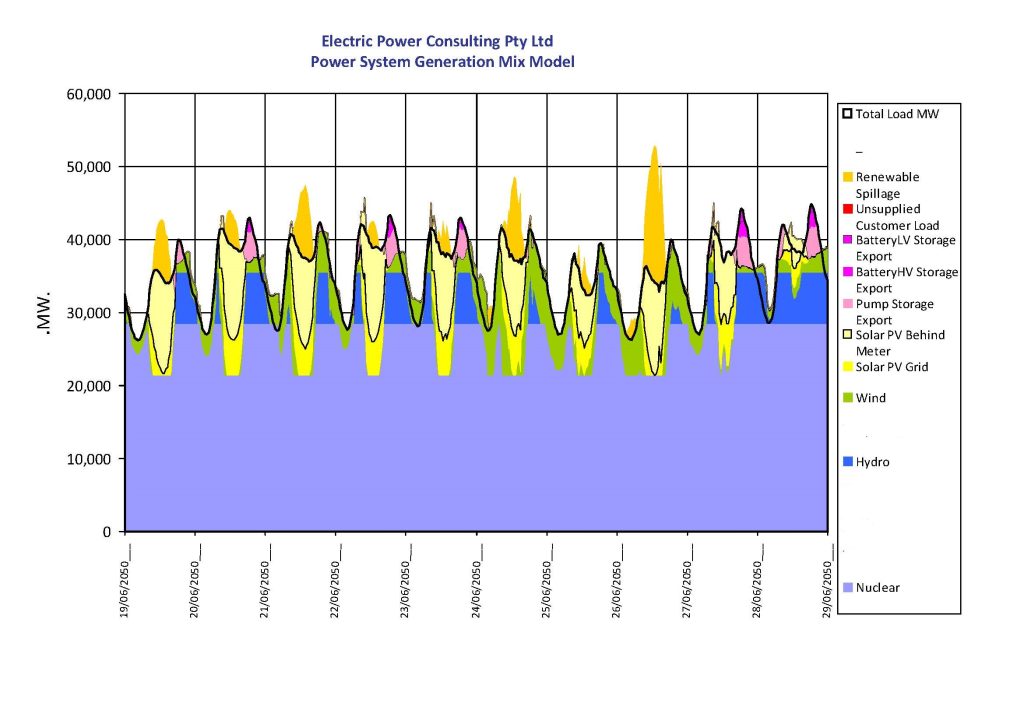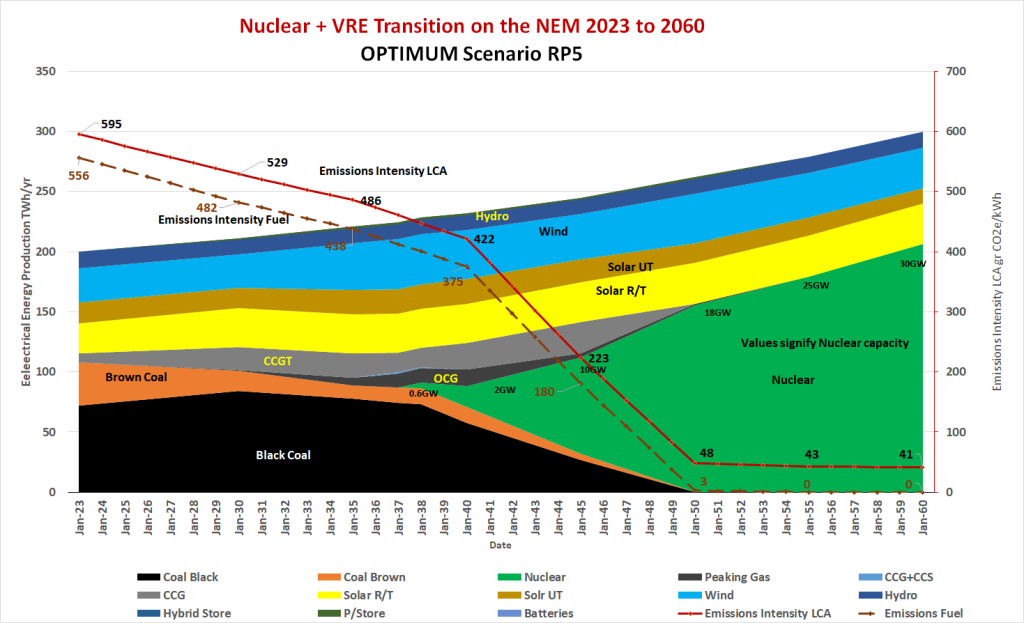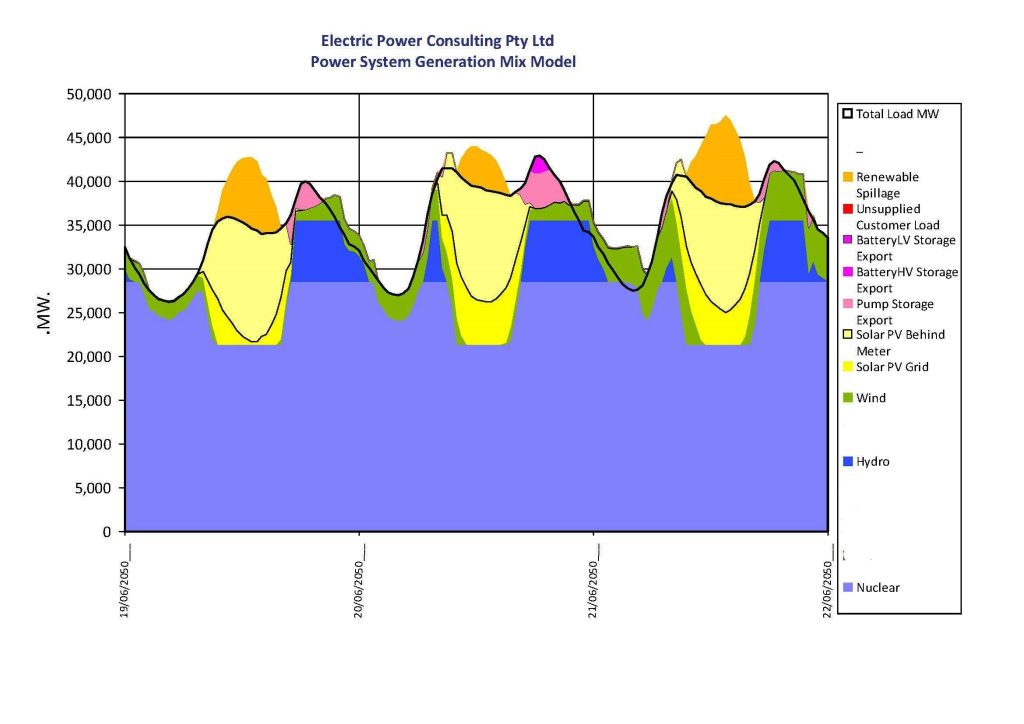
Nuclear Plan for the NEM – Low Cost, Low Carbon, Reliable
Edition 5 21/02/2025
Nuclear Energy – vital for low cost, reliable, low emissions energy
On this previous page Analysing Our Electrical Energy Options we established that nuclear energy is our lowest cost, ultra low carbon option for the National Electricity Market –
On this page we outline a proposed timeline forthe roll out of a nuclear energy plan as shownin the following figure – A Nuclear energy Transition for the NEM.
The assumed NEM load in 2050 is 260 TWh/yr and in 2060 is 300 TWh/yr. This approximates to the AEMO Progressive Change Scenario and is based on anticipated population growth plus electrification of our motor vehicle fleet and increased industrial electrification.
Relevant parameters are:A proposed timeline
- Roll out is completed in 2060 with 30 GW of installed nuclear capacity using large plant such as the AP1000 or APR1000. The system would also contain small plants such as the BWRX 300 or i-SMR.
- Nuclear plants operate at 79% capacity factor in 2060.
- Installed wind is 18.4GW, Grid solar – 8.8 GW and roof top solar is 26.3GW. This is similar to current levels.
- Emissions intensity in 2060 on an LCA basis is 41 g CO2/kWh & cost to consumers is 35.5 c/kWh
- Emissions in 2050 are 48 gr CO2/kWh (LCA), 3 gr CO2/kWh Burned Fossil Fuel (BFF) or about 1/3rd that of the Step Change Scenario in the same year.
- The nuclear scenario removes all fossil fuel plants more quickly than both AEMO’s Step Change and Progressive Change Scenarios. Coal plants stop in 2049 while in the AEMO Progressive Change they remain in place at 1.5GW together with 15.5 GW of Open Cycle gas. Step Change still has 24.8 GW of gas in 2050.
- Gas consumption is minimised to prevent the construction of stranded assets and minimise electricity costs.
Description of the Plan
The nuclear energy plan evolves to achieve in 2050 and 2060 a mix of renewables and nuclear energy in the following capacities and proportions
2050 2060
Nuclear 18GW 60% 30GW 69%
Roof Top Solar 26.3GW 13.2% 26.3GW 11.2%
Grid Solar 8.8GW 6.3% 8.8GW 4.3%
Wind 18.4GW 15.8% 18.4GW 11.1%
Hydro 7.05GW 5.2% 7.05GW 4.5%
Gas OCG 2.08GW 0.4% 0GW
Total Energy 260TWh 300TWh
Emissions
BFF g-CO2/kWh 3 0
LCA g-CO2/kWh 48 41
A detailed breakdown of capacities and outputs for all generators and storage devices is contained in the following Excel File
RP5 text – Capacites and Energy outputs
Nuclear Integrated System Plan for Australia
In the following image we see the integration of nuclear energy operating as a baseload resources together with wind, solar hydro and energy storage.
The load in this case is for ten days in a June month with a wind drought from the 20th to 24th of the month
 Model output, 10 days in June with wind drought[/caption]
Model output, 10 days in June with wind drought[/caption]
The nuclear generators meet the baseload demand while during the day utility and domestic solar paired with storage and hydro meets the peak demands
Three day detailed description
In this three day image note the black demand curve.
- Nuclear provides 69% base load
- Solar in excess of demand goes to battery and pumped storage or is curtailed (orange colour)
- Hydro up to 4.5% of demand provides remainder
- Battery and pumped storage are operating – pink tones


